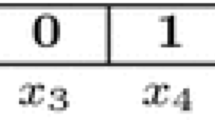Abstract
The set covering problem (SCP) is one of the most representative combinatorial optimization problems and it has multiple applications in different situations of engineering, sciences and some other disciplines. It aims to find a set of solutions that meet the needs defined in the constraints having lowest possible cost. In this paper we used an existing binary algorithm inspired by Binary Black Holes (BBH), to solve multiple instances of the problem with known benchmarks obtained from the OR-library. The presented method emulates the behavior of these celestial bodies using a rotation operator to bring good solutions. After tray this algorithm, we implemented some improvements in certain operators, as well as added others also inspired by black holes physical behavior, to optimize the search and exploration to improving the results.
Access this chapter
Tax calculation will be finalised at checkout
Purchases are for personal use only
Similar content being viewed by others
References
Vasko, F., Wolf, F., Stott, K.: Optimal selection of ingot sizes via set covering. Oper. Res. 35(3), 346–353 (1987)
Desrochers, M., Soumis, F.: A column generation approach to the urban transit crew scheduling problem. Transp. Sci. 23(1), 1–13 (1989)
Bellmore, M., Ratliff, H.D.: Optimal defense of multi-commodity networks. Manage. Sci. 18(4–part–i), B-174 (1971)
Garfinkel, R.S., Nemhauser, G.L.: Optimal political districting by implicit enumeration techniques. Manage. Sci. 16(8), B–495 (1970)
Amini, F., Ghaderi, P.: Hybridization of harmony search and ant colony optimization for optimal locating of structural dampers. Appl. Soft Comput. 13(5), 2272–2280 (2013)
Karp, R.: Reducibility among combinatorial problems (1972). http://www.cs.berkeley.edu/~luca/cs172/karp.pdf
Hatamlou, A.: Black hole: a new heuristic optimization approach for data clustering. Inf. Sci. 222, 175–184 (2013)
Hawking, S.: Agujeros negros y pequeños universos. Planeta, Buenos Aires (1994)
Hawking, S., Jackson, M.: A Brief History of Time. Dove Audio, Beverly Hills (1993)
Ataim, P.: Resolución del problema de set-covering usando un algoritmo genético (2005)
Crawford, B., Soto, R., Olivares-Suarez, M., Palma, W., Paredes, F., Olguín, E., Norero, E.: A binary coded firefly algorithm that solves the set covering problem. Sci. Technol. 17(3), 252–264 (2014)
Farahmandian, M., Hatamlou, A.: Solving optimization problems using black hole algorithm. J. Adv. Comput. Sci. Technol. 4(1), 68–74 (2015)
Beasley, J.: Or-library (1990). http://people.brunel.ac.uk/~mastjjb/jeb/orlib/scpinfo.html
Beasley, J.E.: An algorithm for set covering problem. Eur. J. Oper. Res. 31(1), 85–93 (1987)
Gervasi, O., Murgante, B., Misra, S., Gavrilova, M.L., Rocha, A.M.A.C., Torre, C., Taniar, D., Apduhan, B.O.: Computational Science and Its Applications-ICCSA 2015, vol. 9157. Springer, Cham (2015)
Nemati, M., Salimi, R., Bazrkar, N.: Black holes algorithm: a swarm algorithm inspired of black holes for optimization problems. IAES Int. J. Artif. Intell. (IJ-AI) 2(3), 143–150 (2013)
Acknowledgements
Álvaro Gómez is supported by Postgraduate Grant Pontificia Universidad Católica de Valparaíso 2015 (INF-PUCV 2015). Broderick Crawford is supported by Grant CONICYT/FONDECYT/REGULAR/1140897. Ricardo Soto is supported by Grant CONICYT/FONDECYT/INICIACION/11130459. Adrián Jaramillo is supported by Postgraduate Grant Pontificia Universidad Católica de Valparaíso 2015 (INF-PUCV 2015). Sebastián Mansilla is supported by Postgraduate Grant Pontificia Universidad Católica de Valparaíso 2015 (INF-PUCV 2015). Juan Salas is supported by Postgraduate Grant Pontificia Universidad Católica de Valparaíso 2015 (INF-PUCV 2015).
Author information
Authors and Affiliations
Corresponding authors
Editor information
Editors and Affiliations
Rights and permissions
Copyright information
© 2016 Springer International Publishing Switzerland
About this paper
Cite this paper
Rubio, Á.G. et al. (2016). An Binary Black Hole Algorithm to Solve Set Covering Problem. In: Fujita, H., Ali, M., Selamat, A., Sasaki, J., Kurematsu, M. (eds) Trends in Applied Knowledge-Based Systems and Data Science. IEA/AIE 2016. Lecture Notes in Computer Science(), vol 9799. Springer, Cham. https://doi.org/10.1007/978-3-319-42007-3_74
Download citation
DOI: https://doi.org/10.1007/978-3-319-42007-3_74
Published:
Publisher Name: Springer, Cham
Print ISBN: 978-3-319-42006-6
Online ISBN: 978-3-319-42007-3
eBook Packages: Computer ScienceComputer Science (R0)




